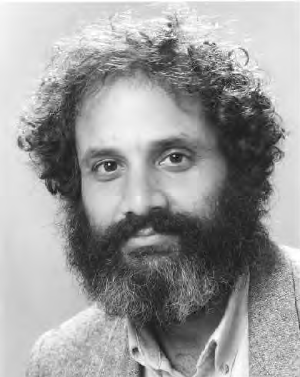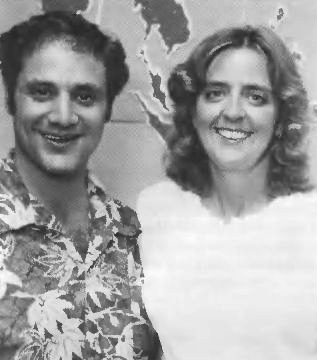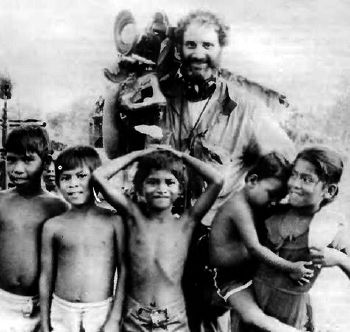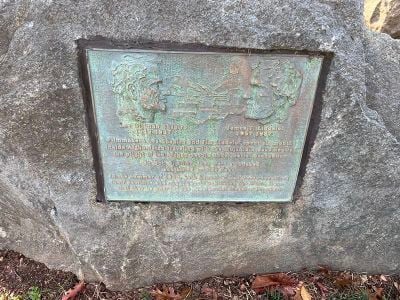Lee Shapiro
Lee Shapiro (1949–1987) was an American documentary filmmaker. His one feature-length film, Nicaragua Was Our Home, was released in 1986. It was filmed in Nicaragua among the Miskitos who were then fighting against Nicaraguan government forces.
Shapiro was motivated by his compassion for fellow human beings, and a desire to bring them joy and fulfillment in their lives. When he became aware of intense suffering, he used his skills as a filmmaker to bring the tragedy of those people's lives to the world, hoping to lessen their suffering through public action.
In 1987, Shapiro and fellow filmmaker Jim Lindelof were killed while filming in Afghanistan during the Soviet–Afghan War. Their desire was to bring the suffering of the Afghan people to the attention of the world. While it took a further 20 years for this to happen, their sacrifice for the sake of those unable to tell their own tragic story bore fruit finally due to the efforts of Shapiro's friends.
Life
Lee Dittman Shapiro was born on May 12, 1949 in Oklahoma.
He began his education planning to become a psychiatrist. While attending medical school at the University of Oklahoma he became interested in film and transferred to the London Film School. On his return to the United States, in 1974 he joined the Unification Church, and attended the Unification Theological Seminary (UTS) from 1976-1978.
While a student at UTS he was known for performing comedy skits together with another student, Michael Jenkins, to the great delight of students and staff. Jenkins said of him:
Our friendship is one of the most rewarding and endearing relationships of my life. Lee is a very jovial and stable person. He has that rare gift of being able to find a joyful outlook on every activity he is engaged in.[1]
Shapiro filmed the first graduation ceremony at UTS, in 1977. After graduating, he went to make various documentary films for the Unification Church, including "Ocean Challenge" (1980). He continued making films for various organizations, including CAUSA International, an anticommunist organization launched in 1980 that focused on Latin America.
Shapiro married Linda Krout Shapiro on July 1, 1982 at a marriage Blessing Ceremony officiated by Reverend Sun Myung Moon and Hak Ja Han Moon.
Through his work in Latin America, Shapiro witnessed the situation in Nicaragua of the Miskito people and decided to make a documentary film about their suffering:
In Nicaragua, a new side of Lee Shapiro emerged that none of us had seen before: He was willing to live in the jungle and even starve in order to bring the Miskito Indians' situation to the attention of the free world. When he returned, I could see that his drive and his commitment to film making was now turned towards the saving of people and nations. There was a fearlessness about this. We knew he'd lived in great danger, but he never referred to it.[1]
The result was Nicaragua Was Our Home (1985).[2]
Shapiro died in October, 1987, ambushed while filming in Afghanistan.[3]
Nicaragua Was Our Home
Nicaragua Was Our Home was filmed in Nicaragua among the Miskitos who were then fighting against Nicaraguan government forces. It features interviews with Miskito Indian people and some non-Miskito clergy who lived among them concerning actions of the government against them, including bombing of villages, shootings, and forced removal of people from their homes.[4]
The film was shown nationally on PBS stations to critical acclaim, and at the 1986 Sundance Film Festival where it was nominated for a Documentary Grand Jury Prize, and at the Chicago International Film Festival where it was nominated for a Gold Hugo award for Best Documentary.[5]
Afghanistan
After completing the film on the Miskitos in Nicaragua, Shapiro became interested in the situation in Afghanistan:
Because there was so little coverage of the Soviet occupation of Afghanistan, Lee wanted to get into the heart of the country and bring this tragedy to the world. ... Lee hoped that the film would move the public toward action that could help end the Afghan people's suffering.[1]
Shapiro contacted Aziz Sadat, an Afghan native who had come to the United States as a student in 1979 and had maintained close relations with the Afghan resistance. In September, 1986, Sadat and Shapiro arrived in Peshawar to make contact with Hezb-e Islami Gulbuddin, one of the largest and most militantly fundamentalist Islamic guerrilla groups. After spending two months there, Shapiro returned to the United States.
There he met Jim Lindelof, a paramedic who had previously spent time in Afghanistan with a team providing medical care to rebels in Panjshir Valley. Both Lindelhof and Shapiro were frustrated with the lack of media coverage, and had the idea of shooting a documentary film to raise public awareness. Shapiro had received grant money for the film, and needed an assistant. Lindelhof was the right man for the job. In March 1987 they returned to Afghanistan.[6]
Shapiro and Lindelof spent six months traveling with the Mujahideen, documenting the plight of the Afghan people under Soviet occupation. However, before they could complete filming, they were ambushed and killed outside Kabul:
The campaign to target foreign journalists had more tragic results. Two American filmmakers, Lee Shapiro and Jim Lindelof, were apparently killed by a regime attack while traveling with the mujahidin. In 1986, Lindelof had been named paramedic of the year for his efforts training Afghan medical workers. In response to protests, Kabul stated it could not "guarantee the security of foreign subjects" who enter illegally, whose presence it views as "evidence" of "external interference."[7]
The armed group they were traveling with reported that they had been ambushed by military forces of the Soviet Union or the Afghan government. However, the details have been questioned, partly because of the poor reputation of the group's leader, Gulbuddin Hekmatyar:
Two American journalists are believed dead in northwest Afghanistan, diplomatic and resistance forces say here. Filmmaker Lee Shapiro and his soundman, Jim Lindalos, both of New York, were killed Oct. 11, reportedly in a Soviet or Afghan government ambush, according to United States consular officials. However, the resistance group that accompanied the film team has a poor reputation among most informed observers, and doubts have arisen over whether the two Americans did indeed die in an Afghan government or Soviet attack.[8]
Details of the incident remained unclear, even the exact date of their deaths was not ascertained, with some reports stating October 9 and others October 11. Their bodies were never recovered:
Filmmaker Lee Shapiro, who set out to show what horrors were being inflicted upon Afghanistan and its people during the Soviet invasion, remained in the country after he and other journalists were warned that they were in grave danger. While traveling to find and interview one of Afghanistan’s moderate leaders in his rural headquarters, Shapiro and his cameraman, Jim Lindelof, disappeared. They were reportedly caught in a fire fight between Soviet troops and the Mujaheddin. While their deaths were announced, their bodies were never found.[9]
Legacy
In 1988, both houses of Congress passed a bill recommending that Shapiro and Lindelof, along with journalist Charles Thornton, receive the Presidential Medal of Freedom.[10] A historical marker was installed in the Congressional Cemetery in Washington DC, to commemorate Shapiro and Lindelhof.[11]
In 2006 the documentary film Shadow of Afghanistan,[12] by Suzanne Bauman and Jim Burroughs and incorporating footage originally shot by Shapiro, was released. Close friends of Shapiro, they decided to make a film about Afghanistan in order to pay homage to their friend and allow his footage to be seen:
A wonderful documentary, 20 years in the making, is Shadow of Afghanistan. Lee Shapiro began shooting in 1986 and the film has some of the most startling yet intimate footage ever seen of a country at war. Shapiro and his soundman Jim Lindelof disappeared while filming. The footage was obtained by another filmmaking team who saw it to completion by a skeleton crew's labor of love, not least of whom is editor Mary Ann Skweres' contribution to the entire film cut. Shadow of Afghanistan has already had an Academy qualifying run and is also vying for an Independent Spirit Award nomination."[13]
The film premiered at the Tribeca Film Festival in 2006, and was updated for DVD release in 2012.[9] Suzanne Bauman was nominated for an Alliance of Women Film Journalists EDA Female Focus Award, and Bauman and Burroughs won the EDA Special Mention Award for Best of the Fests.
On October 9, 1987, documentary filmmakers Lee Shapiro and James Lindelof were killed during an ambush while making a film about the Mujahideen in Soviet-occupied Afghanistan. Jim Burroughs and Suzanne Bauman have incorporated the footage created by their fallen comrades into a documentary that fits recent, post-September 11 events into a context that stretches all the way back to 1959 and the reign of King Mohammed Zahir Shah. ... Burroughs and Bauman return to Tora Bora, once the turf of the Mujahideen and now home to the recently vacated headquarters of al-Qaeda, and find that the land has not really changed much since Biblical times. ... Burroughs and Bauman have created an unusual, emotional, and personal film that weaves together over twenty years of footage shot by them and by Shapiro and Lindelof-including interviews with Russian and Afghan soldiers and never-before-seen footage of al-Qaeda members-into a film about the Afghan people's struggle for self-determination.[14]
Shapiro willingly gave his life to bring the stories of suffering people to the attention of the world. Although he could not complete his work, sacrificing his life in Afghanistan, his footage was finally brought to the public through the efforts of his friends. His wife Linda noted:
Lee once told me that if he were to die, the best way would be on the front line with the people he was trying to serve. Neither he nor I want others to cry for us, but rather for the people in Afghanistan and Nicaragua, and all those who are miserably suffering under the evils of communism.[1]
His legacy is not just that their story be told in a beautiful and compelling way, but that his efforts help bring an end to their suffering. President Ronald Reagan, after watching Nicaragua Was Our Home, said of Shapiro that he was "a man of conscience," and that "Your work...is motivated not only by an artist's desire to tell the story and tell it well, but also by your hatred of injustice and your compassion for its victims."[1]
Notes
- ↑ 1.0 1.1 1.2 1.3 1.4 Victoria Clevenger, Lee Dittman Shapiro TParents.org, December 1987. Retrieved September 23, 2023.
- ↑ Nicaragua Was Our Home IMDb. Retrieved September 23, 2023.
- ↑ William G. Blair, 2 Americans Reported Killed In an Ambush in Afghanistan The New York Times (October 28, 1987). Retrieved September 23, 2023.
- ↑ John Corry, On 13, Sandinistas vs. Miskitos, The New York Times (July 29, 1986). Retrieved September 23, 2023.
- ↑ Nicaragua Was Our Home Awards IMDb. Retrieved September 23, 2023.
- ↑ Nikki Finke, Under Fire: An Afghan Odyssey : California Medical Technician and New Jersey Film Maker Give Their Lives Telling Story of Rebels Los Angeles Times (October 30, 1987). Retrieved September 23, 2023.
- ↑ Craig Karp, Afghanistan: eight years of Soviet occupation Department of State Bulletin 88(2132) (March 1988). Retrieved September 22, 2023.
- ↑ Edward Girardet, Two US journalists reported killed in Afghanistan; details murky Christian Science Monitor (October 28, 1987). Retrieved September 22, 2023.
- ↑ 9.0 9.1 Jennifer Merin, Documentary Retroview: Shadow of Afghanistan 1959-2012 (2006, 2012) Alliance of Women Film Journalists (Aug 17, 2021). Retrieved September 22, 2023.
- ↑ H.Con.Res.260 — 100th Congress (1987-1988) Congress.gov. Retrieved September 23, 2023.
- ↑ Lee Dittman Shapiro 1949-1987 / James T. Lindelof 1957-1987 Historical Marker Database. Retrieved September 23, 2023.
- ↑ Shadow of Afghanistan (2006) IMDb. Retrieved September 23, 2023.
- ↑ Paige Donner, In Honor of The Annapolis, Md. Middle East Peace Talks: A Short Viewing/Reading List Huffington Post (May 25, 2011). Retrieved September 22, 2023.
- ↑ Shadow of Afghanistan Tribeca Film Institute. Retrieved September 22, 2023.
ReferencesISBN links support NWE through referral fees
- Burroughs, Jim, and Suzanne Bauman. Shadow of Afghanistan: 1959-2012. Burbank, CA: Cinema Libre Studio, 2012. ASIN B006XF2QGM
- Kaplan, Robert D. Soldiers of God: With Islamic Warriors in Afghanistan and Pakistan. New York: Vintage, 2001. ASIN 1400030250
- Shapiro, Lee. Nicaragua Was Our Home. Chicago, IL: Films Inc., 1985. ASIN B000UWKMP6
External links
All links retrieved March 11, 2025.
- Lee Shapiro at the Internet Movie Database
- Nicaragua Was Our Home (1985) IMDb
- Shadow of Afghanistan (2006) IMDB
- Lee Dittman Shapiro by Victoria Clevenger, December, 1987.
- Lee Dittman Shapiro 1949-1987 / James T. Lindelof 1957-1987 The Historical Marker Database
- Lee Shapiro by Erwin Franzen, December 10, 1987.
- In Memoriam: Lee Shapiro — October 9th 1987 Robin Graham, October 4, 2012.
Credits
New World Encyclopedia writers and editors rewrote and completed the Wikipedia article in accordance with New World Encyclopedia standards. This article abides by terms of the Creative Commons CC-by-sa 3.0 License (CC-by-sa), which may be used and disseminated with proper attribution. Credit is due under the terms of this license that can reference both the New World Encyclopedia contributors and the selfless volunteer contributors of the Wikimedia Foundation. To cite this article click here for a list of acceptable citing formats.The history of earlier contributions by wikipedians is accessible to researchers here:
The history of this article since it was imported to New World Encyclopedia:
Note: Some restrictions may apply to use of individual images which are separately licensed.



